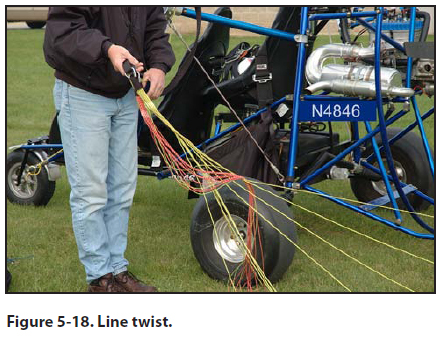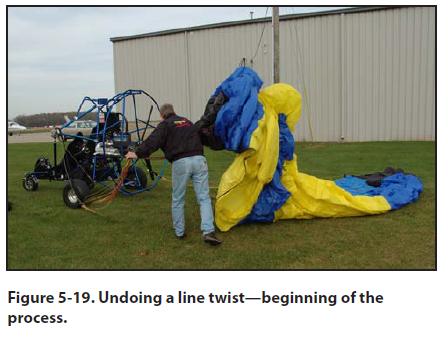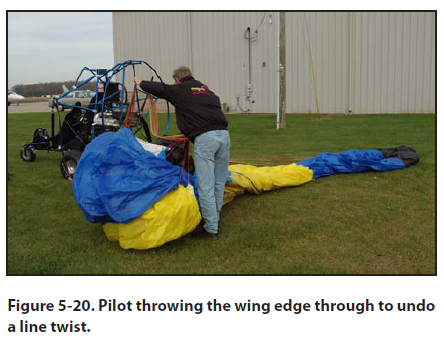|
Chapter 5 — Preflight and Ground Operations
Line Twists
A line twist is when all of the lines on both sides of
the wing are spiraled together. Sometimes it will seem
that all of the lines on one side are twisted around
the steering line. That is actually the case. [Figure
5-18] Trying to fly the powered parachute with the
suspension lines twisted is unsafe and the pilot should
consider the wing unairworthy until the line twist is
removed. Line twists most often occur because the
pilot inadvertently flips, or turns, the wing over while
moving it from the stowed position. This is why it is
so important to put your wing away and take it out the
same way each time. The suspension lines can also
get twisted if the wing flies over the cart accidentally,
or if the wing is incorrectly repositioned behind the
cart when the wing settles to one side of the cart during
an aborted takeoff or during landing.

Unless someone has mistakenly twisted a single set
of suspension lines while rigging the PPC wing to the
cart at the attachment points, a line twist will happen
to both sets of lines on both sides of the powered parachute
at the same time. This stands to reason if you
think of the entire configuration of cart and attached
wing as a continuous structure or a complete circle.
To get rid of a line twist, you do not have to pack the
wing back into the wing bag and flip the whole bag in
reverse, although this is an option. You can actually
flip the wing while it is out of the bag.
With the wing laid out behind the cart, determine if
the twist is clockwise or counterclockwise in configuration.
If the twist in the line is traveling clockwise as
you face the chute, the wing edge you are working with
will have to travel counterclockwise back through the center of the two sets of lines (or through the center of
the circle created by the cart/wing configuration) and
under the twisted group of lines you are holding. A
counterclockwise twist will require just the opposite
movement. The wing edge will need to travel clockwise
under the line set and then up and over the twist
via the center of the circle. Remember to maintain the
clockwise motion for the counterclockwise twist, and
the counterclockwise motion for the clockwise twist.
Disconnecting the wing from the risers or the wing
from the cart is not a safe practice; the flight instructor
needs to explain this to the PPC student in detail. The
risers are specific to each cart. Refer to the PPC manufacturer
and the operating manual for information.
Starting at the riser cables, gather all the lines in the
group and walk toward the wing keeping the lines
gathered as you go. Once close to the wing, you can
easily manipulate the edge of the wing and not tangle
the lines any further. The key is to remember that the
lines are twisted as a group—not tangled individually—
therefore they must be untwisted as a group to
prevent them from becoming tangled. [Figures 5-19
and 5-20]
 
Lay out the half of the wing you just worked on. If that
side looks good, it means you can do the same thing
to the other side of the chute. The same sequence of
checking for twist direction, gathering the lines and
then twisting the wing edge in the opposite direction
of the twisted lines is completed on the second set of
lines. It stands to reason that the twist will be in the
opposite direction than the twist on the other set of
lines you just cleared.
There is a possibility that the side you are working
on still doesn’t look right when you re-check it. If the
lines still look twisted, then you probably flipped the
wing the wrong way. The good news is that there are
only the two types of line twists, clockwise and counterclockwise—
with a little practice you will be able
to recognize the twist well before you start handling
the wing.
|

